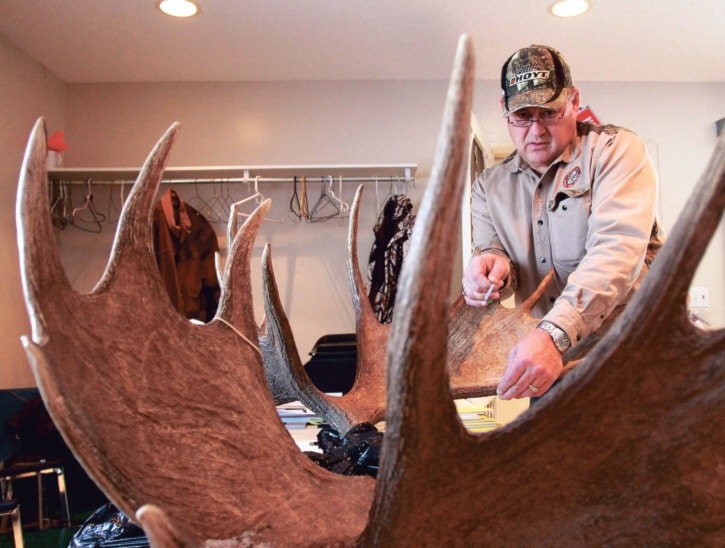With hunting season over, sports men and women can now see how their catch measures up to others’.
The Ponoka Fish and Game Association held its annual horn-measuring day Dec. 8 at its Lake Pofianga camp. Hunters brought in their trophies to see how they stacked up to the rest. They had to wait for a final score from certified Boone and Crockett scoring judges to measure the horns or antlers of animals.
Some horns are more desirable than others, explained president Leonard Davis. When hunters bring in their antlers, they can submit them as typical or non-typical. A typical horn is supposed to look a certain way but some are brought in with characteristics that have an interesting look. There are different theories why horns become non-typical, said Davis. “Myself, I think they have been injured.”
He prefers a more symmetrical horn but has a friend who prefers to see non-typical antlers. “I’ve got a friend who loves stuff hanging all over the place.”
“To me, they look nicer because they have a whole bunch more character,” said Big Game chairman Ray Abt.
Determining the score of a set of horns is an entirely different challenge, explained Abt. While judges have a scoring system they use for reference, determining that length changes from person to person. Where a person measures from on the horns determines the length.
“There was a non-typical mule deer taken in the States a few years ago. They had 50 Boone and Crockett measurers measure the horn. They came up with 50 different measurements,” said Abt.
For him a non-typical mule deer or whitetail is the toughest horn to measure. “It’s all judgment.”
The hunter makes the designation when entering a trophy whether they want it to be judged as a typical or non-typical catch. Abt’s job is to ensure he follows the guidelines for either entry.
Another system used to measure trophies is Pope and Young scoring, which Davis said is basically the same as Boone and Crockett, except that it is judged on archery rather than rifles. “There’s virtually no difference.”
He said many of the Ponoka Fish and Game members are certified to use bows and the sport is growing in Alberta. Davis estimates approximately half of the hunters in Alberta use bows.
“(Why) the interest in bows? It’s more challenging,” he said.
While a rifle shoots 300 to 400 yards, a bow’s range is approximately 60 yards. “You gotta see the whites of their eyes.”
For some hunters, the sport is a family affair. Ron Tebb was proud to show off his granddaughter Jaycee’s first catch. She was hunting with her family and while her parents did not catch any animals in the season, they were proud she and granddad both had a catch.
“I was happy for her, it was exciting,” said her mother.
With seven minutes left in the season, Jaycee nabbed a whitetail deer with her Savage 243 youth rifle.
“Down to the wire,” said grandfather Tebb.
She is proud of the catch. Jaycee has been hunting with the family since she was young. “Ever since I could walk I was out duck hunting.”
There were 25 entrants that came to the horn measuring.
